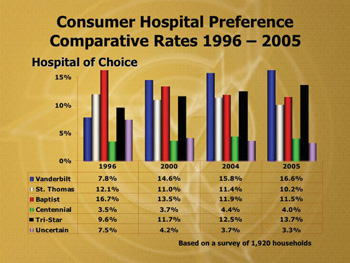
Infection control efforts land awards
Kathie Wilkerson, R.N., one of Vanderbilt University Medical Center's growing team of infection control practitioners (ICPs), recently received two awards recognizing her contribution to a collaborative infection control program implemented in the Medical Intensive Care Unit (MICU).
At the national meeting of the Association of Professionals in Infection Control and Epidemiology (APIC), the preeminent professional society for ICPs, Wilkerson and her colleagues (including Julie Foss, R.N., nursing director of the MICU, Martha Newton, database analyst for the Center for Clinical Improvement and Richard Wall, M.D., M.P.H., a former VA Quality Scholar who pioneered the project) received a Blue Ribbon Award for having one of the top submitted abstracts at the meeting. In addition, the Centers for Disease Control and Prevention also recognized Wilkerson with a scholarship and a citation for her efforts to reduce hospital-acquired infections.
Wilkerson presented the results of an intervention initiated in 2002 to combat bloodstream infections in MICU patients with central intravenous catheters (central lines). The intervention included mandatory online training for medical and nursing staff, bedside checklists identifying evidence-based insertion practices and real-time performance feedback.
Since implementing these standardized procedures in October 2002, bloodstream infections in MICU patients with central lines have decreased by about 75 percent. The results suggest that standardizing certain practices can have a major impact on hospital-acquired infections.
“Kathie's abstract was one of only three that was cited from across the nation,” said associate hospital epidemiologist Thomas R. Talbot, M.D., M.P.H., and co-author on the abstract. “I think that's a testament not only to Kathie, but the whole group. With Kathie leading the way, we're now taking that intervention to all of our intensive care units.”
But even the most well-researched and designed intervention cannot succeed without the cooperation of nursing and medical staff.
“It was exciting to receive the CDC/APIC award for our group's hard work and dedication,” Wilkerson said. “I especially would like give credit to the MICU nursing staff and physicians who have been willing to participate in this project and have been supportive of our efforts to reduce bloodstream infections.”
The awards highlight the significant progress being made by the expanding infection control efforts at VUMC as well as the leadership role VUMC is taking at the national level.
Directed by Hospital Epidemiologist William Schaffner, M.D., the department of Infection Control has grown significantly over the past few years. Since 2002, the department has doubled its nursing staff to six and has added two additional epidemiologists, Talbot, and Jacob J. Nania, M.D., who oversees infection control at the Monroe Carell Jr. Children's Hospital at Vanderbilt. And, as the Medical Center increases its services, Schaffner predicts that the Infection Control team will grow in concert.
While the team oversees, advises, assists and analyzes infection control efforts around the Medical Center, Schaffner points out that “infection control is everyone's responsibility.”
“Make sure you wash your hands and do the right things to prevent infection…we can't do it for you. Everyone has to do their own infection control,” Schaffner said.
This message appears to be resounding across the campus, with many units initiating their own infection control interventions. Interventions aimed at reducing ventilator-associated pneumonia in Surgical Critical Care units, bloodstream infection and pneumonia initiatives at Children's Hospital, and procedures to improve the delivery of prophylactic antibiotics to surgical patients suggest that “the entire Medical Center seems to be attuned to preventing infections and improving patient safety,” Talbot said.
The Infection Control team not only monitors infections at Vanderbilt but also provides information on infection control practices to others nationally and internationally, Talbot said.
“Our goal is, while enhancing infection control locally, to also serve as one of the major recognized leaders in infection control and health care epidemiology.”
The VUMC staff has traditionally been involved in infection control at the national level. Schaffner, an internationally recognized expert in epidemiology, is a past-president and longtime member of a premiere scholarly society for infection control professionals, the Society for Healthcare Epidemiology of America (SHEA). In addition, Vicki Brinsko, R.N., Infection Control Coordinator and lead ICP, is a member of the CDC's Hospital Infection Control Practices Advisory Committee (HICPAC).
This committee makes national guidelines for identifying, reporting and combating hospital-acquired infections.
VUMC has also participated in the CDC's National Nosocomial Infection Surveillance (NNIS) system from its establishment in the early 1970s. Only about 300 hospitals of the several thousand across the United States voluntarily submit their hospital-acquired infection data into the CDC's NNIS database. Although the data are confidential, this system helps infection control professionals and hospitals to assess and better manage their hospital-acquired infections.
“Vanderbilt has had a substantial presence on the national scene in infection control and has a reputation, which now through Tom, we're going to take to a higher level,” Schaffner said.
Talbot's direction for VUMC infection control has “put in place the expectation that our infection control practitioners will do not only the routine supremely well, but will also be doing special projects that can be taken to national meetings and influence practice around the country. (These awards) are the first fruits of that.”
Although hospital-acquired infections can never be completely eradicated, the MICU intervention provides hope that improving infection control strategies can lead to significant decreases in infection rates and better patient outcomes.
“This means,” said Schaffner, “that we're always working on improving what we do and trying to do it better.
“Thirty years ago, we had much less ill patients getting much less aggressive medical care,” he said. “The remarkable thing is that hospital-acquired infection rates have remained at the same level or have actually been reduced despite the fact that the single most important determinant of hospital-based infections has become more serious — patients have gotten sicker and we treat them much more aggressively.”
“That is a testament to infection control across the country,” he said. “And that is a story that nobody tells.”













